System Analysis Report: CRM for Australian Fashion Design - ICT700
VerifiedAdded on 2023/06/11
|15
|2442
|336
Report
AI Summary
This document presents a system analysis of Customer Relationship Management (CRM) implementation, focusing on the application of the Agile model. It includes a comparison of various Software Development Life Cycle (SDLC) models such as Spiral, Agile, and RAD, recommending Agile for its flexibility and suitability for managing evolving requirements. The analysis incorporates User Centered Design (UCD) and Human Computer Interaction (HCI) principles to enhance usability. Furthermore, the document provides a detailed event table, domain class model, class diagram, use case model, and use case descriptions to illustrate the system's functionality and interactions. This comprehensive analysis offers insights into designing and implementing an effective CRM system tailored to meet the needs of Australian Fashion Design (AFD).

Running head: SYSTEM ANALYSIS OF CRM
SYSTEM ANALYSIS OF CRM
Name of the Student
Name of the University
Author Note:
SYSTEM ANALYSIS OF CRM
Name of the Student
Name of the University
Author Note:
Paraphrase This Document
Need a fresh take? Get an instant paraphrase of this document with our AI Paraphraser
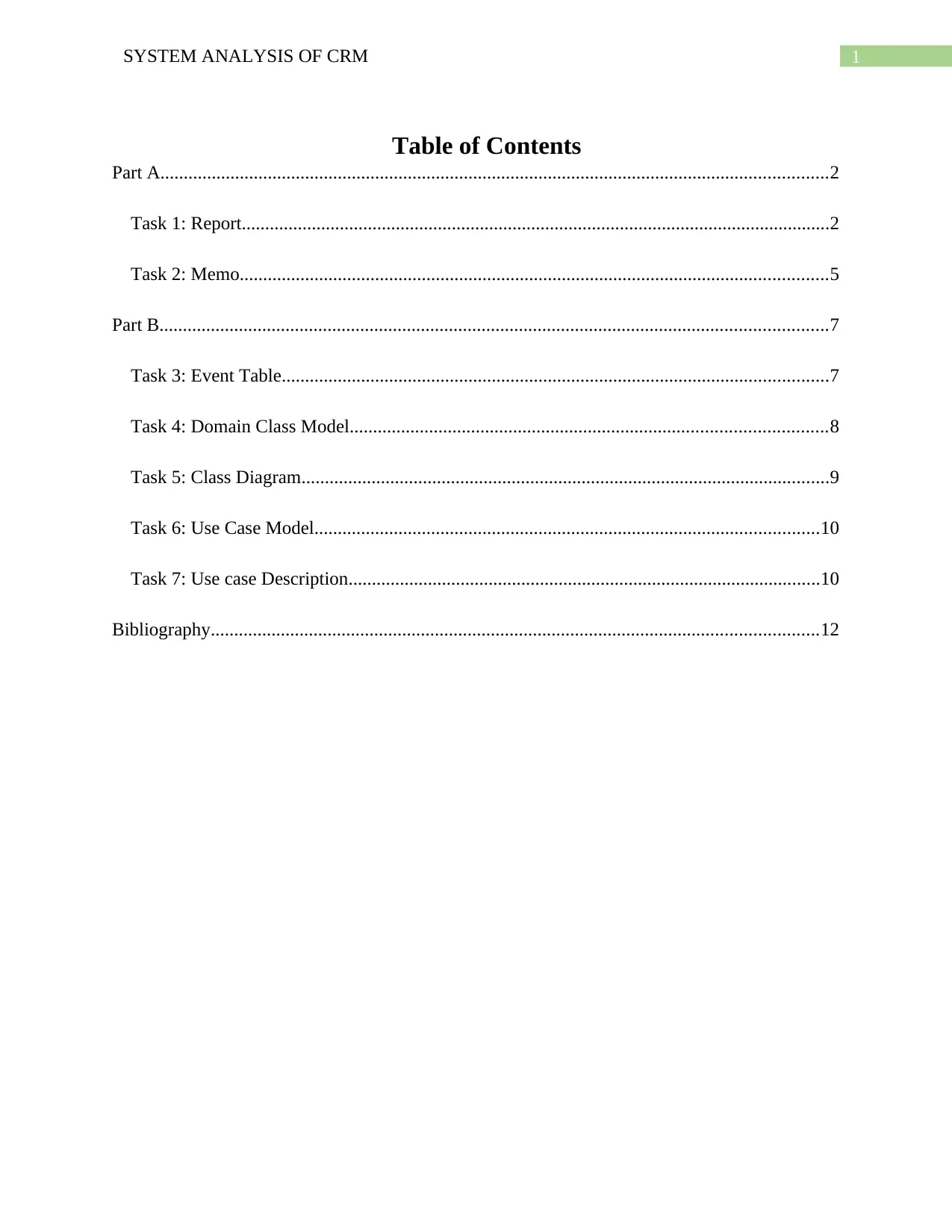
1SYSTEM ANALYSIS OF CRM
Table of Contents
Part A...............................................................................................................................................2
Task 1: Report..............................................................................................................................2
Task 2: Memo..............................................................................................................................5
Part B...............................................................................................................................................7
Task 3: Event Table.....................................................................................................................7
Task 4: Domain Class Model......................................................................................................8
Task 5: Class Diagram.................................................................................................................9
Task 6: Use Case Model............................................................................................................10
Task 7: Use case Description.....................................................................................................10
Bibliography..................................................................................................................................12
Table of Contents
Part A...............................................................................................................................................2
Task 1: Report..............................................................................................................................2
Task 2: Memo..............................................................................................................................5
Part B...............................................................................................................................................7
Task 3: Event Table.....................................................................................................................7
Task 4: Domain Class Model......................................................................................................8
Task 5: Class Diagram.................................................................................................................9
Task 6: Use Case Model............................................................................................................10
Task 7: Use case Description.....................................................................................................10
Bibliography..................................................................................................................................12
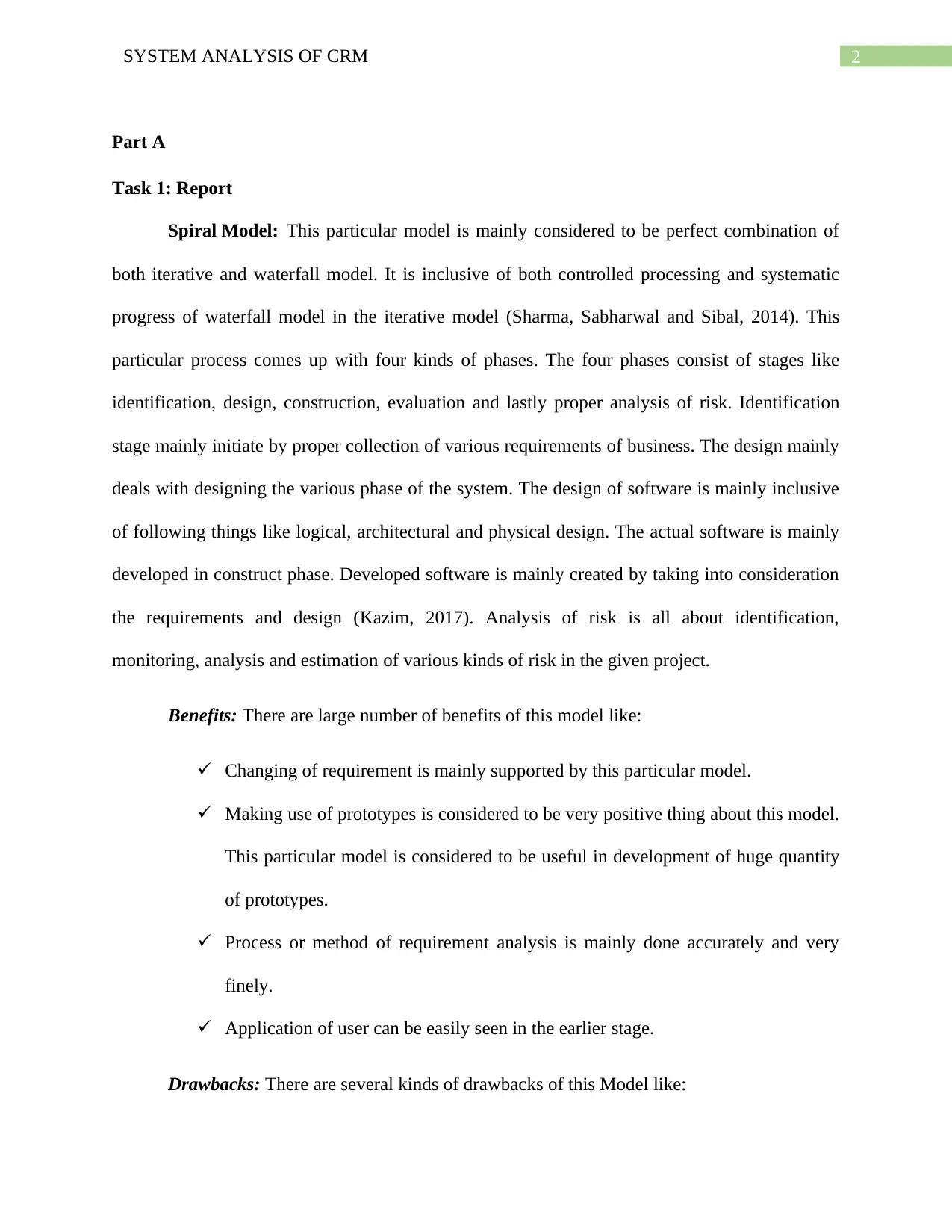
2SYSTEM ANALYSIS OF CRM
Part A
Task 1: Report
Spiral Model: This particular model is mainly considered to be perfect combination of
both iterative and waterfall model. It is inclusive of both controlled processing and systematic
progress of waterfall model in the iterative model (Sharma, Sabharwal and Sibal, 2014). This
particular process comes up with four kinds of phases. The four phases consist of stages like
identification, design, construction, evaluation and lastly proper analysis of risk. Identification
stage mainly initiate by proper collection of various requirements of business. The design mainly
deals with designing the various phase of the system. The design of software is mainly inclusive
of following things like logical, architectural and physical design. The actual software is mainly
developed in construct phase. Developed software is mainly created by taking into consideration
the requirements and design (Kazim, 2017). Analysis of risk is all about identification,
monitoring, analysis and estimation of various kinds of risk in the given project.
Benefits: There are large number of benefits of this model like:
Changing of requirement is mainly supported by this particular model.
Making use of prototypes is considered to be very positive thing about this model.
This particular model is considered to be useful in development of huge quantity
of prototypes.
Process or method of requirement analysis is mainly done accurately and very
finely.
Application of user can be easily seen in the earlier stage.
Drawbacks: There are several kinds of drawbacks of this Model like:
Part A
Task 1: Report
Spiral Model: This particular model is mainly considered to be perfect combination of
both iterative and waterfall model. It is inclusive of both controlled processing and systematic
progress of waterfall model in the iterative model (Sharma, Sabharwal and Sibal, 2014). This
particular process comes up with four kinds of phases. The four phases consist of stages like
identification, design, construction, evaluation and lastly proper analysis of risk. Identification
stage mainly initiate by proper collection of various requirements of business. The design mainly
deals with designing the various phase of the system. The design of software is mainly inclusive
of following things like logical, architectural and physical design. The actual software is mainly
developed in construct phase. Developed software is mainly created by taking into consideration
the requirements and design (Kazim, 2017). Analysis of risk is all about identification,
monitoring, analysis and estimation of various kinds of risk in the given project.
Benefits: There are large number of benefits of this model like:
Changing of requirement is mainly supported by this particular model.
Making use of prototypes is considered to be very positive thing about this model.
This particular model is considered to be useful in development of huge quantity
of prototypes.
Process or method of requirement analysis is mainly done accurately and very
finely.
Application of user can be easily seen in the earlier stage.
Drawbacks: There are several kinds of drawbacks of this Model like:
⊘ This is a preview!⊘
Do you want full access?
Subscribe today to unlock all pages.

Trusted by 1+ million students worldwide
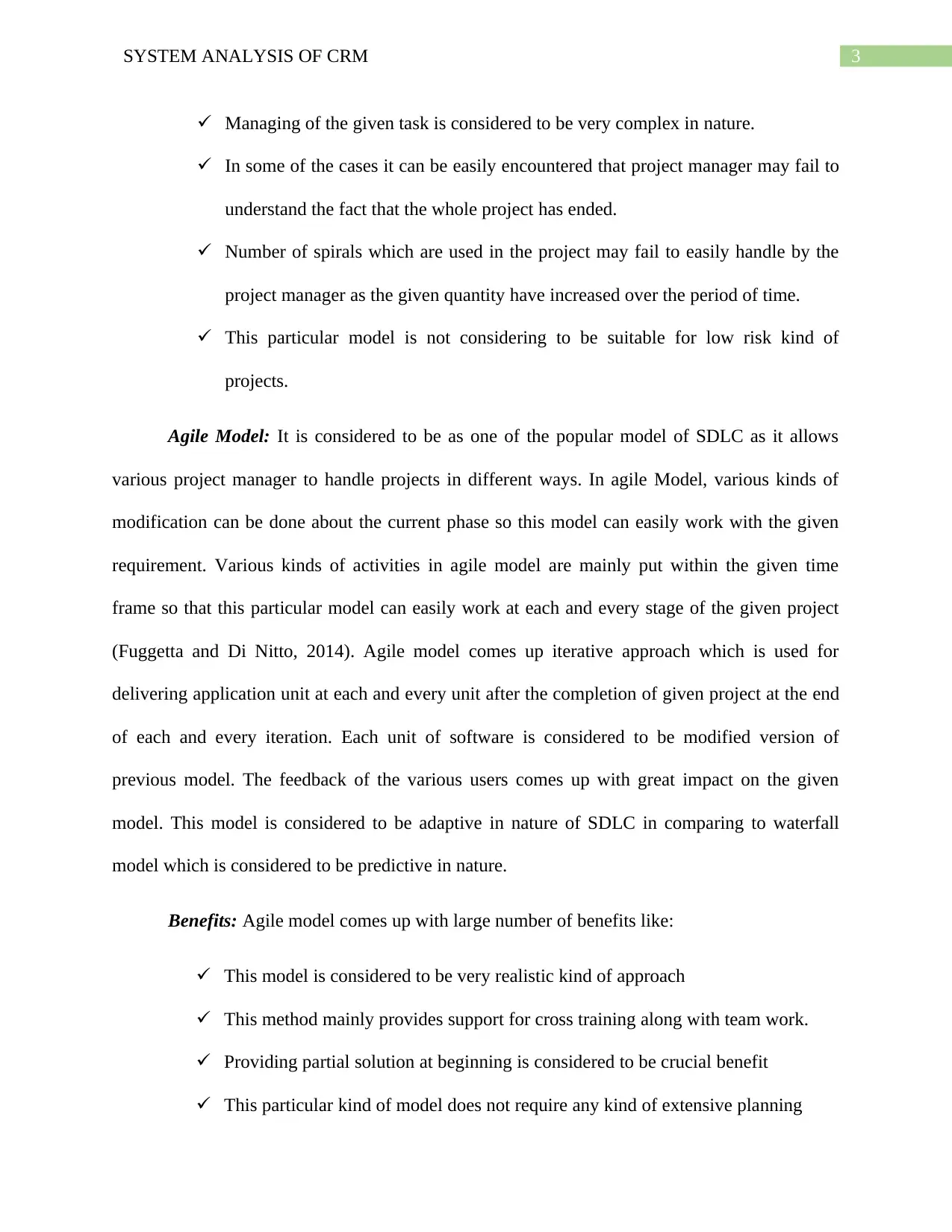
3SYSTEM ANALYSIS OF CRM
Managing of the given task is considered to be very complex in nature.
In some of the cases it can be easily encountered that project manager may fail to
understand the fact that the whole project has ended.
Number of spirals which are used in the project may fail to easily handle by the
project manager as the given quantity have increased over the period of time.
This particular model is not considering to be suitable for low risk kind of
projects.
Agile Model: It is considered to be as one of the popular model of SDLC as it allows
various project manager to handle projects in different ways. In agile Model, various kinds of
modification can be done about the current phase so this model can easily work with the given
requirement. Various kinds of activities in agile model are mainly put within the given time
frame so that this particular model can easily work at each and every stage of the given project
(Fuggetta and Di Nitto, 2014). Agile model comes up iterative approach which is used for
delivering application unit at each and every unit after the completion of given project at the end
of each and every iteration. Each unit of software is considered to be modified version of
previous model. The feedback of the various users comes up with great impact on the given
model. This model is considered to be adaptive in nature of SDLC in comparing to waterfall
model which is considered to be predictive in nature.
Benefits: Agile model comes up with large number of benefits like:
This model is considered to be very realistic kind of approach
This method mainly provides support for cross training along with team work.
Providing partial solution at beginning is considered to be crucial benefit
This particular kind of model does not require any kind of extensive planning
Managing of the given task is considered to be very complex in nature.
In some of the cases it can be easily encountered that project manager may fail to
understand the fact that the whole project has ended.
Number of spirals which are used in the project may fail to easily handle by the
project manager as the given quantity have increased over the period of time.
This particular model is not considering to be suitable for low risk kind of
projects.
Agile Model: It is considered to be as one of the popular model of SDLC as it allows
various project manager to handle projects in different ways. In agile Model, various kinds of
modification can be done about the current phase so this model can easily work with the given
requirement. Various kinds of activities in agile model are mainly put within the given time
frame so that this particular model can easily work at each and every stage of the given project
(Fuggetta and Di Nitto, 2014). Agile model comes up iterative approach which is used for
delivering application unit at each and every unit after the completion of given project at the end
of each and every iteration. Each unit of software is considered to be modified version of
previous model. The feedback of the various users comes up with great impact on the given
model. This model is considered to be adaptive in nature of SDLC in comparing to waterfall
model which is considered to be predictive in nature.
Benefits: Agile model comes up with large number of benefits like:
This model is considered to be very realistic kind of approach
This method mainly provides support for cross training along with team work.
Providing partial solution at beginning is considered to be crucial benefit
This particular kind of model does not require any kind of extensive planning
Paraphrase This Document
Need a fresh take? Get an instant paraphrase of this document with our AI Paraphraser
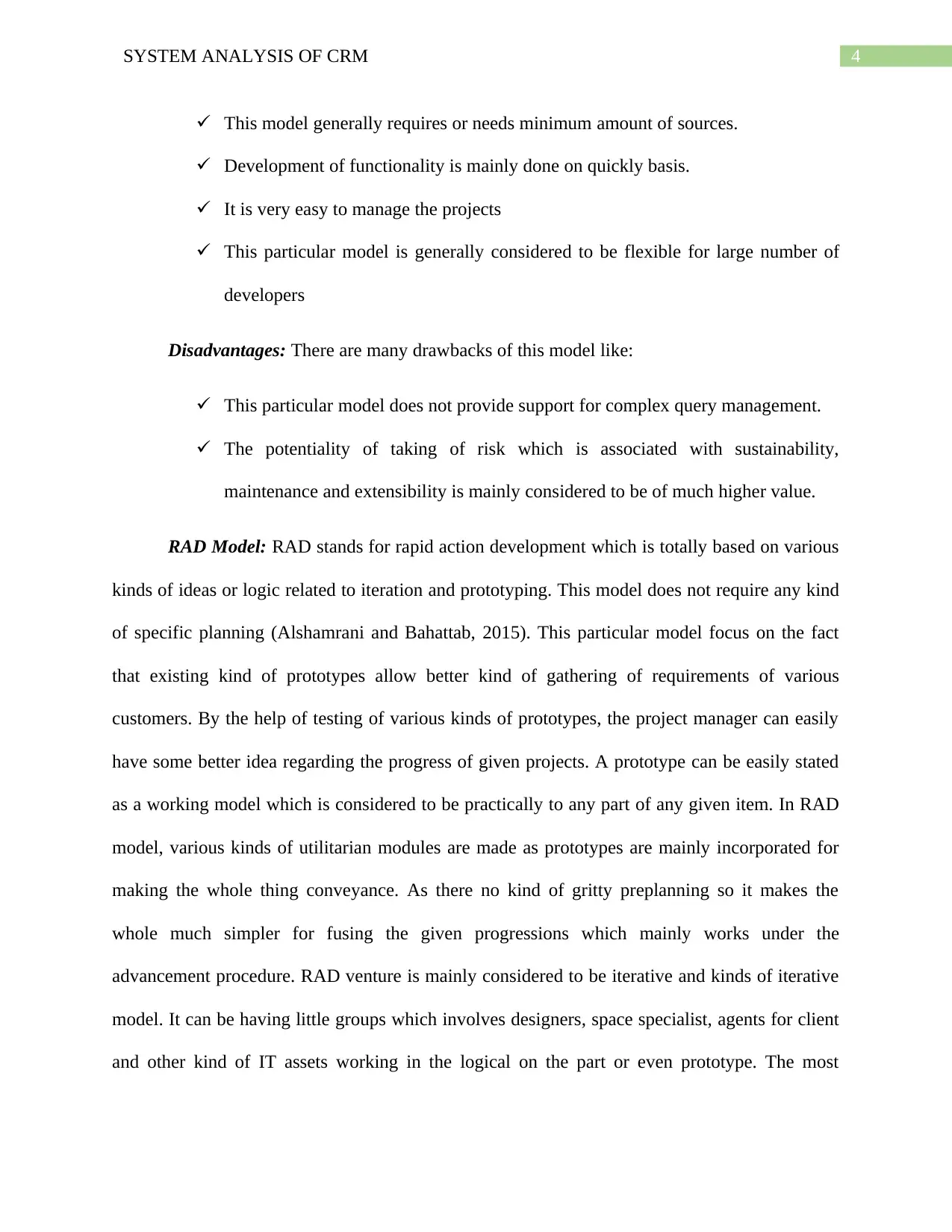
4SYSTEM ANALYSIS OF CRM
This model generally requires or needs minimum amount of sources.
Development of functionality is mainly done on quickly basis.
It is very easy to manage the projects
This particular model is generally considered to be flexible for large number of
developers
Disadvantages: There are many drawbacks of this model like:
This particular model does not provide support for complex query management.
The potentiality of taking of risk which is associated with sustainability,
maintenance and extensibility is mainly considered to be of much higher value.
RAD Model: RAD stands for rapid action development which is totally based on various
kinds of ideas or logic related to iteration and prototyping. This model does not require any kind
of specific planning (Alshamrani and Bahattab, 2015). This particular model focus on the fact
that existing kind of prototypes allow better kind of gathering of requirements of various
customers. By the help of testing of various kinds of prototypes, the project manager can easily
have some better idea regarding the progress of given projects. A prototype can be easily stated
as a working model which is considered to be practically to any part of any given item. In RAD
model, various kinds of utilitarian modules are made as prototypes are mainly incorporated for
making the whole thing conveyance. As there no kind of gritty preplanning so it makes the
whole much simpler for fusing the given progressions which mainly works under the
advancement procedure. RAD venture is mainly considered to be iterative and kinds of iterative
model. It can be having little groups which involves designers, space specialist, agents for client
and other kind of IT assets working in the logical on the part or even prototype. The most
This model generally requires or needs minimum amount of sources.
Development of functionality is mainly done on quickly basis.
It is very easy to manage the projects
This particular model is generally considered to be flexible for large number of
developers
Disadvantages: There are many drawbacks of this model like:
This particular model does not provide support for complex query management.
The potentiality of taking of risk which is associated with sustainability,
maintenance and extensibility is mainly considered to be of much higher value.
RAD Model: RAD stands for rapid action development which is totally based on various
kinds of ideas or logic related to iteration and prototyping. This model does not require any kind
of specific planning (Alshamrani and Bahattab, 2015). This particular model focus on the fact
that existing kind of prototypes allow better kind of gathering of requirements of various
customers. By the help of testing of various kinds of prototypes, the project manager can easily
have some better idea regarding the progress of given projects. A prototype can be easily stated
as a working model which is considered to be practically to any part of any given item. In RAD
model, various kinds of utilitarian modules are made as prototypes are mainly incorporated for
making the whole thing conveyance. As there no kind of gritty preplanning so it makes the
whole much simpler for fusing the given progressions which mainly works under the
advancement procedure. RAD venture is mainly considered to be iterative and kinds of iterative
model. It can be having little groups which involves designers, space specialist, agents for client
and other kind of IT assets working in the logical on the part or even prototype. The most
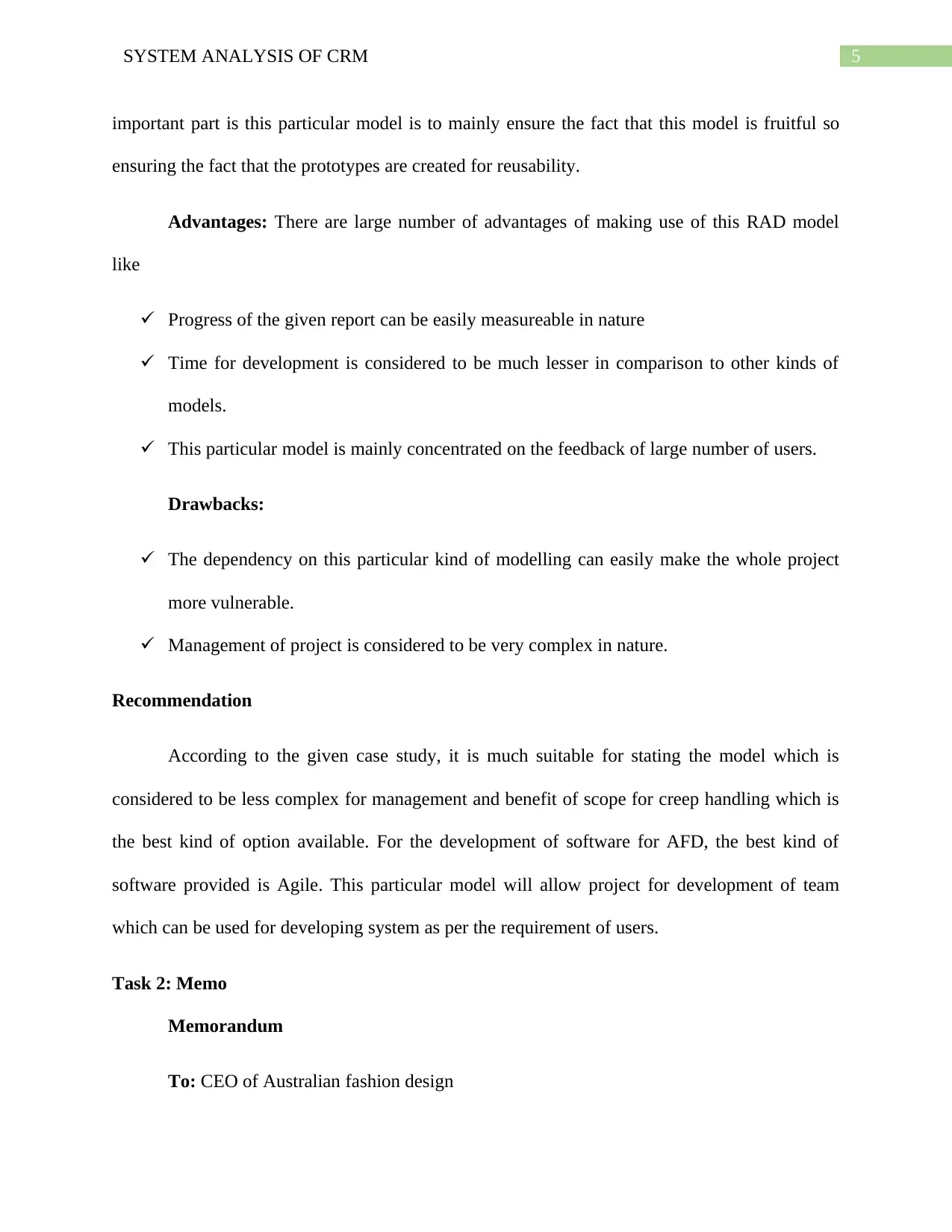
5SYSTEM ANALYSIS OF CRM
important part is this particular model is to mainly ensure the fact that this model is fruitful so
ensuring the fact that the prototypes are created for reusability.
Advantages: There are large number of advantages of making use of this RAD model
like
Progress of the given report can be easily measureable in nature
Time for development is considered to be much lesser in comparison to other kinds of
models.
This particular model is mainly concentrated on the feedback of large number of users.
Drawbacks:
The dependency on this particular kind of modelling can easily make the whole project
more vulnerable.
Management of project is considered to be very complex in nature.
Recommendation
According to the given case study, it is much suitable for stating the model which is
considered to be less complex for management and benefit of scope for creep handling which is
the best kind of option available. For the development of software for AFD, the best kind of
software provided is Agile. This particular model will allow project for development of team
which can be used for developing system as per the requirement of users.
Task 2: Memo
Memorandum
To: CEO of Australian fashion design
important part is this particular model is to mainly ensure the fact that this model is fruitful so
ensuring the fact that the prototypes are created for reusability.
Advantages: There are large number of advantages of making use of this RAD model
like
Progress of the given report can be easily measureable in nature
Time for development is considered to be much lesser in comparison to other kinds of
models.
This particular model is mainly concentrated on the feedback of large number of users.
Drawbacks:
The dependency on this particular kind of modelling can easily make the whole project
more vulnerable.
Management of project is considered to be very complex in nature.
Recommendation
According to the given case study, it is much suitable for stating the model which is
considered to be less complex for management and benefit of scope for creep handling which is
the best kind of option available. For the development of software for AFD, the best kind of
software provided is Agile. This particular model will allow project for development of team
which can be used for developing system as per the requirement of users.
Task 2: Memo
Memorandum
To: CEO of Australian fashion design
⊘ This is a preview!⊘
Do you want full access?
Subscribe today to unlock all pages.

Trusted by 1+ million students worldwide
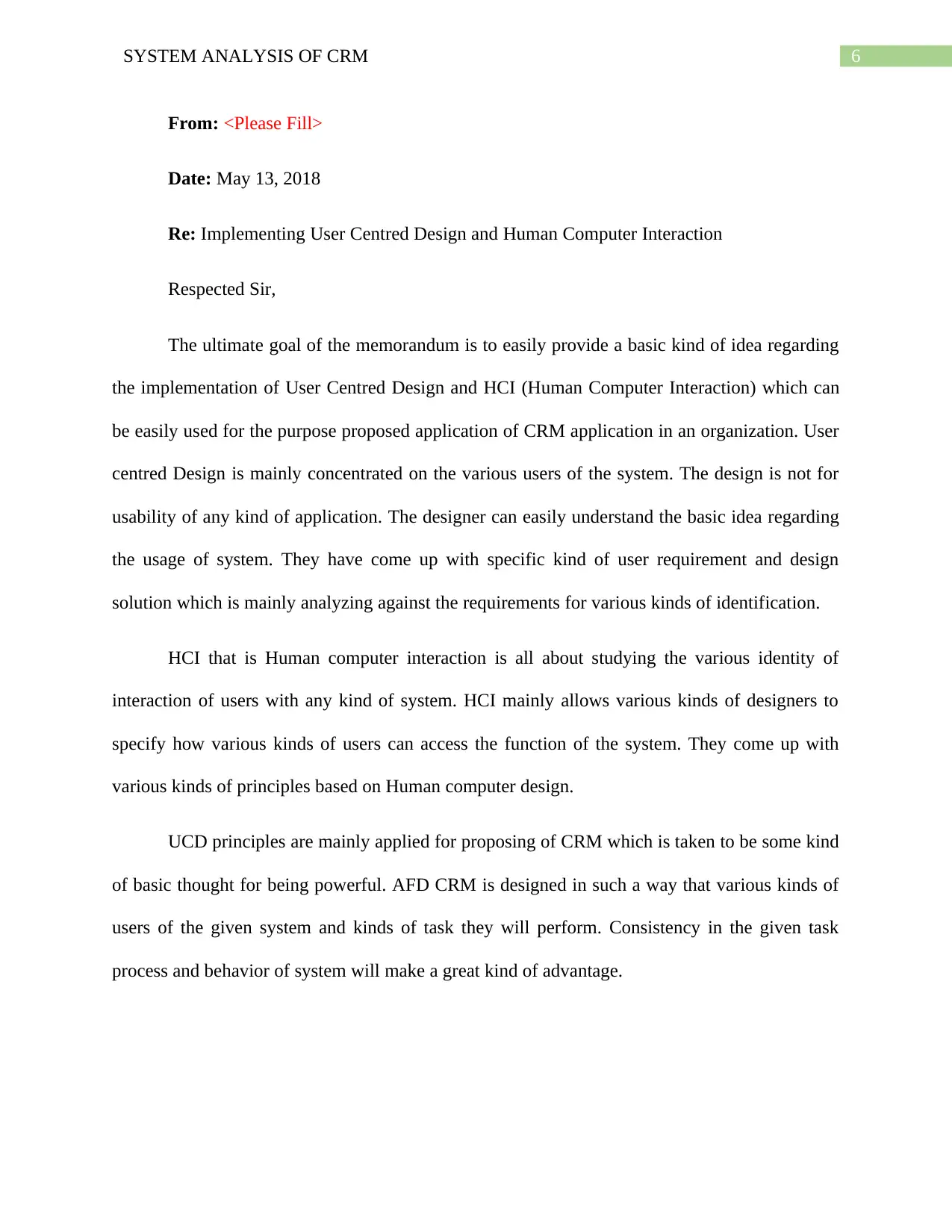
6SYSTEM ANALYSIS OF CRM
From: <Please Fill>
Date: May 13, 2018
Re: Implementing User Centred Design and Human Computer Interaction
Respected Sir,
The ultimate goal of the memorandum is to easily provide a basic kind of idea regarding
the implementation of User Centred Design and HCI (Human Computer Interaction) which can
be easily used for the purpose proposed application of CRM application in an organization. User
centred Design is mainly concentrated on the various users of the system. The design is not for
usability of any kind of application. The designer can easily understand the basic idea regarding
the usage of system. They have come up with specific kind of user requirement and design
solution which is mainly analyzing against the requirements for various kinds of identification.
HCI that is Human computer interaction is all about studying the various identity of
interaction of users with any kind of system. HCI mainly allows various kinds of designers to
specify how various kinds of users can access the function of the system. They come up with
various kinds of principles based on Human computer design.
UCD principles are mainly applied for proposing of CRM which is taken to be some kind
of basic thought for being powerful. AFD CRM is designed in such a way that various kinds of
users of the given system and kinds of task they will perform. Consistency in the given task
process and behavior of system will make a great kind of advantage.
From: <Please Fill>
Date: May 13, 2018
Re: Implementing User Centred Design and Human Computer Interaction
Respected Sir,
The ultimate goal of the memorandum is to easily provide a basic kind of idea regarding
the implementation of User Centred Design and HCI (Human Computer Interaction) which can
be easily used for the purpose proposed application of CRM application in an organization. User
centred Design is mainly concentrated on the various users of the system. The design is not for
usability of any kind of application. The designer can easily understand the basic idea regarding
the usage of system. They have come up with specific kind of user requirement and design
solution which is mainly analyzing against the requirements for various kinds of identification.
HCI that is Human computer interaction is all about studying the various identity of
interaction of users with any kind of system. HCI mainly allows various kinds of designers to
specify how various kinds of users can access the function of the system. They come up with
various kinds of principles based on Human computer design.
UCD principles are mainly applied for proposing of CRM which is taken to be some kind
of basic thought for being powerful. AFD CRM is designed in such a way that various kinds of
users of the given system and kinds of task they will perform. Consistency in the given task
process and behavior of system will make a great kind of advantage.
Paraphrase This Document
Need a fresh take? Get an instant paraphrase of this document with our AI Paraphraser
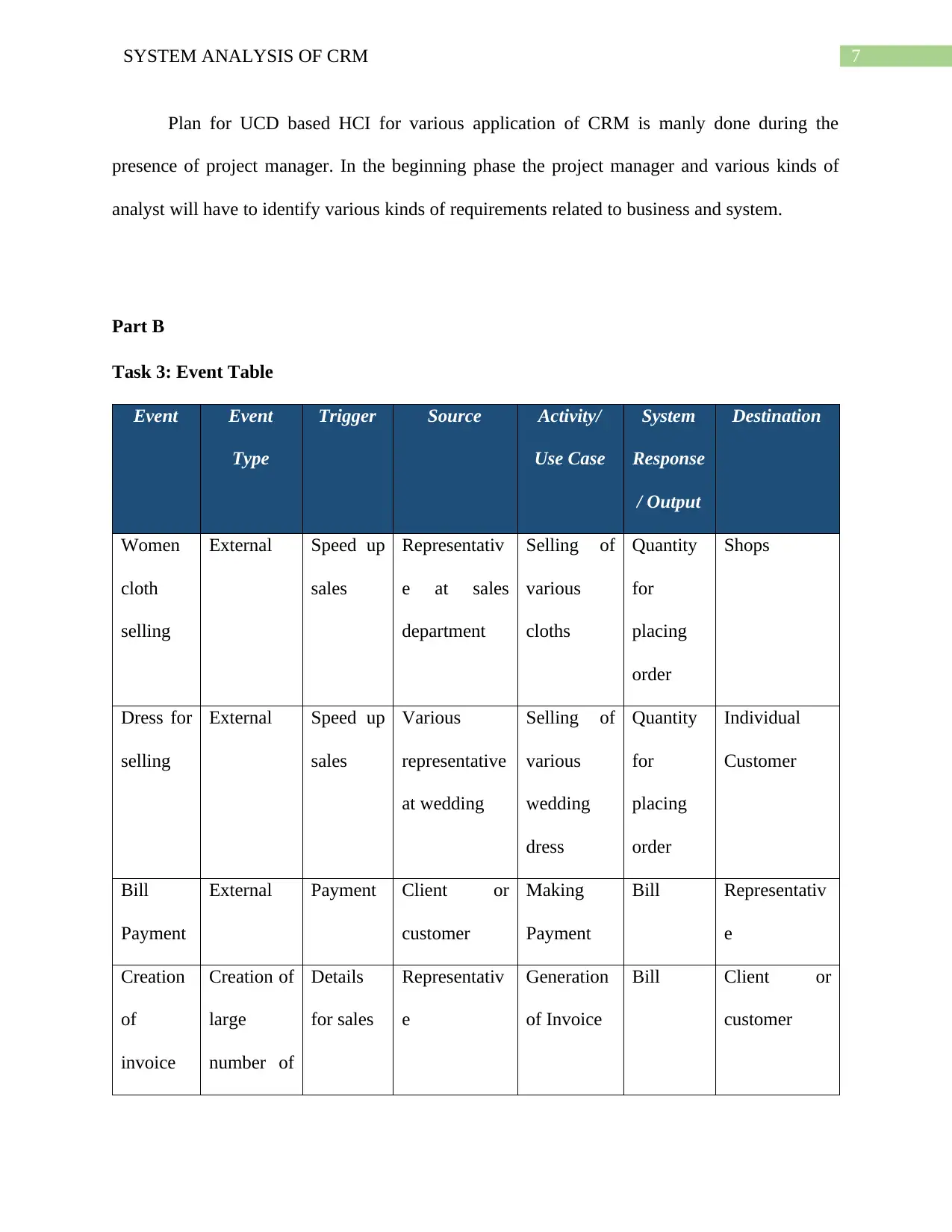
7SYSTEM ANALYSIS OF CRM
Plan for UCD based HCI for various application of CRM is manly done during the
presence of project manager. In the beginning phase the project manager and various kinds of
analyst will have to identify various kinds of requirements related to business and system.
Part B
Task 3: Event Table
Event Event
Type
Trigger Source Activity/
Use Case
System
Response
/ Output
Destination
Women
cloth
selling
External Speed up
sales
Representativ
e at sales
department
Selling of
various
cloths
Quantity
for
placing
order
Shops
Dress for
selling
External Speed up
sales
Various
representative
at wedding
Selling of
various
wedding
dress
Quantity
for
placing
order
Individual
Customer
Bill
Payment
External Payment Client or
customer
Making
Payment
Bill Representativ
e
Creation
of
invoice
Creation of
large
number of
Details
for sales
Representativ
e
Generation
of Invoice
Bill Client or
customer
Plan for UCD based HCI for various application of CRM is manly done during the
presence of project manager. In the beginning phase the project manager and various kinds of
analyst will have to identify various kinds of requirements related to business and system.
Part B
Task 3: Event Table
Event Event
Type
Trigger Source Activity/
Use Case
System
Response
/ Output
Destination
Women
cloth
selling
External Speed up
sales
Representativ
e at sales
department
Selling of
various
cloths
Quantity
for
placing
order
Shops
Dress for
selling
External Speed up
sales
Various
representative
at wedding
Selling of
various
wedding
dress
Quantity
for
placing
order
Individual
Customer
Bill
Payment
External Payment Client or
customer
Making
Payment
Bill Representativ
e
Creation
of
invoice
Creation of
large
number of
Details
for sales
Representativ
e
Generation
of Invoice
Bill Client or
customer
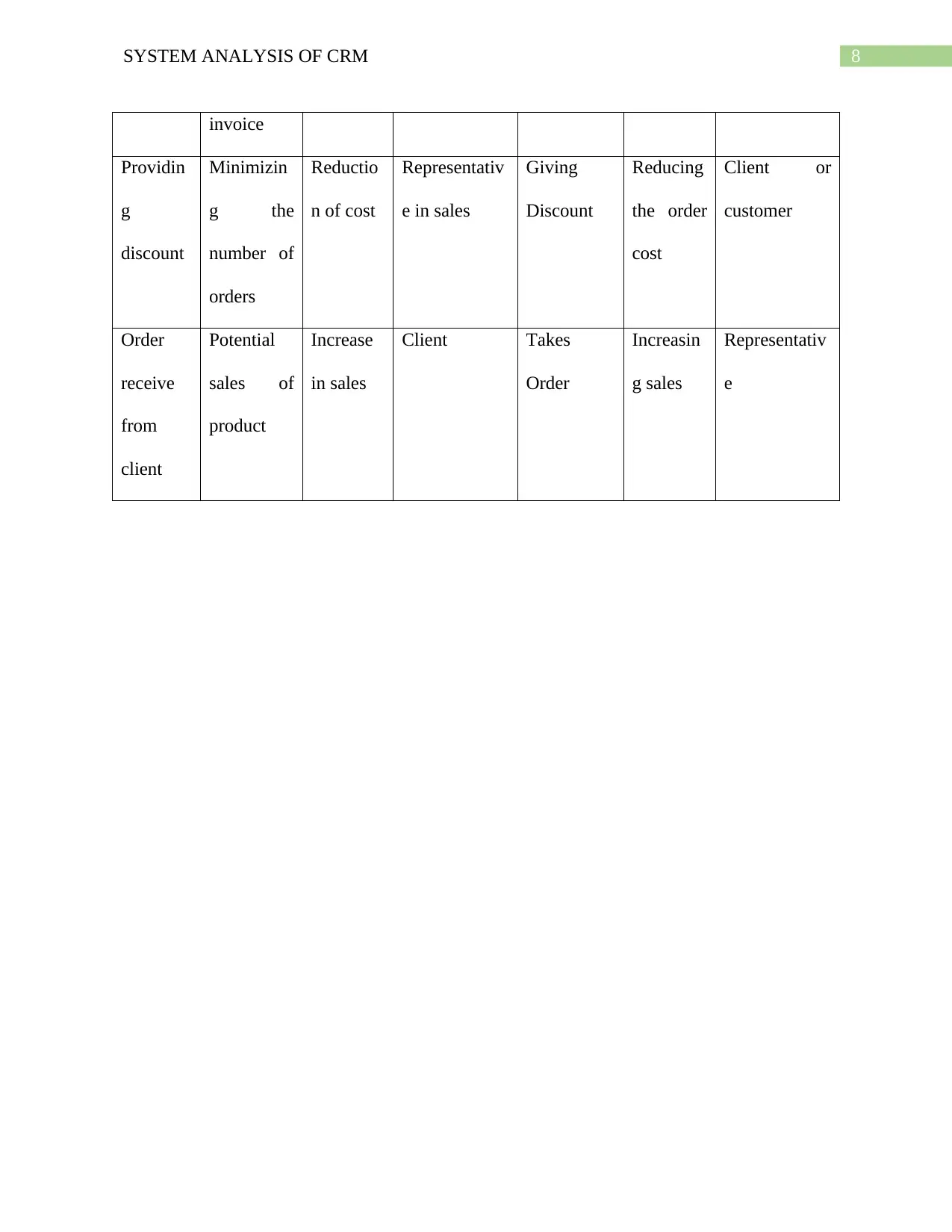
8SYSTEM ANALYSIS OF CRM
invoice
Providin
g
discount
Minimizin
g the
number of
orders
Reductio
n of cost
Representativ
e in sales
Giving
Discount
Reducing
the order
cost
Client or
customer
Order
receive
from
client
Potential
sales of
product
Increase
in sales
Client Takes
Order
Increasin
g sales
Representativ
e
invoice
Providin
g
discount
Minimizin
g the
number of
orders
Reductio
n of cost
Representativ
e in sales
Giving
Discount
Reducing
the order
cost
Client or
customer
Order
receive
from
client
Potential
sales of
product
Increase
in sales
Client Takes
Order
Increasin
g sales
Representativ
e
⊘ This is a preview!⊘
Do you want full access?
Subscribe today to unlock all pages.

Trusted by 1+ million students worldwide
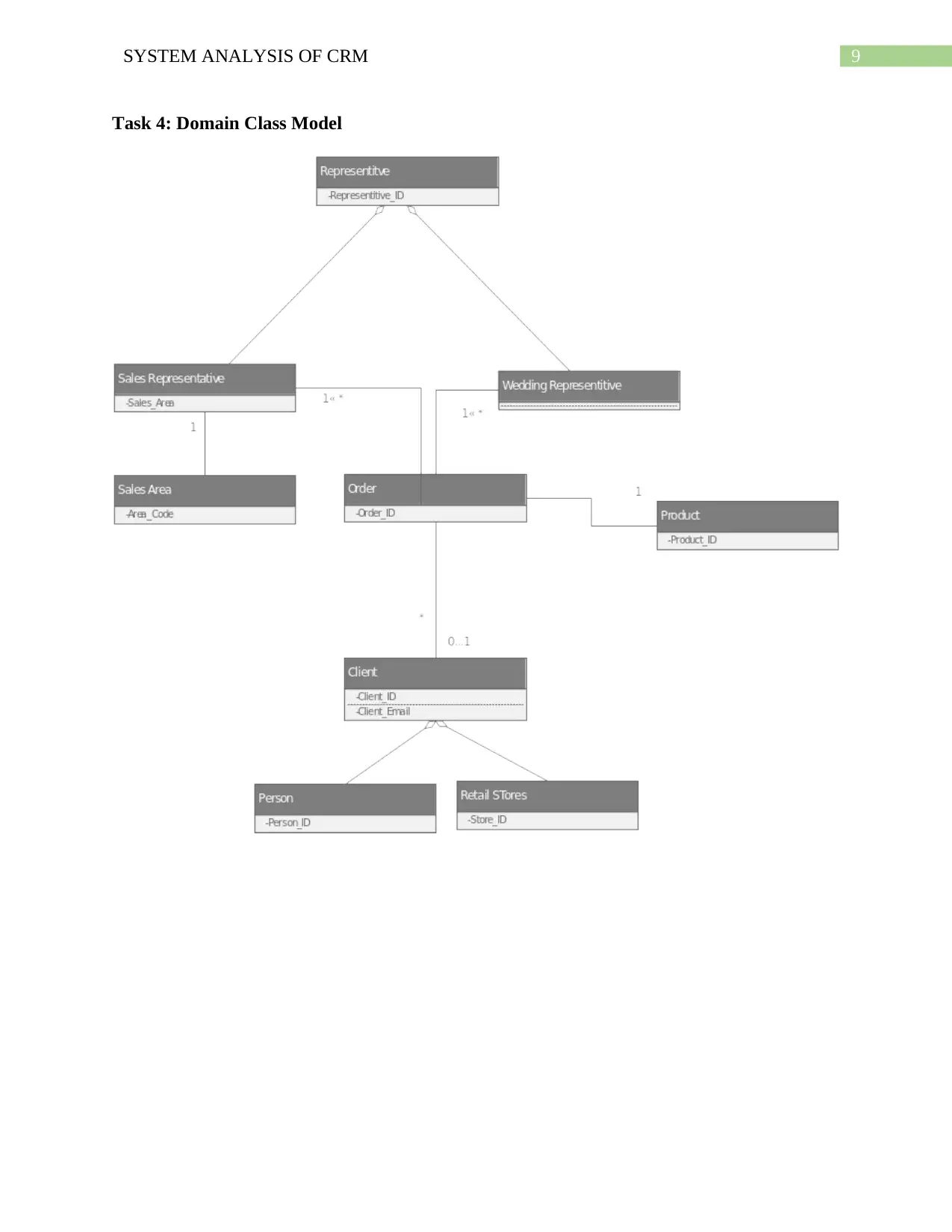
9SYSTEM ANALYSIS OF CRM
Task 4: Domain Class Model
Task 4: Domain Class Model
Paraphrase This Document
Need a fresh take? Get an instant paraphrase of this document with our AI Paraphraser
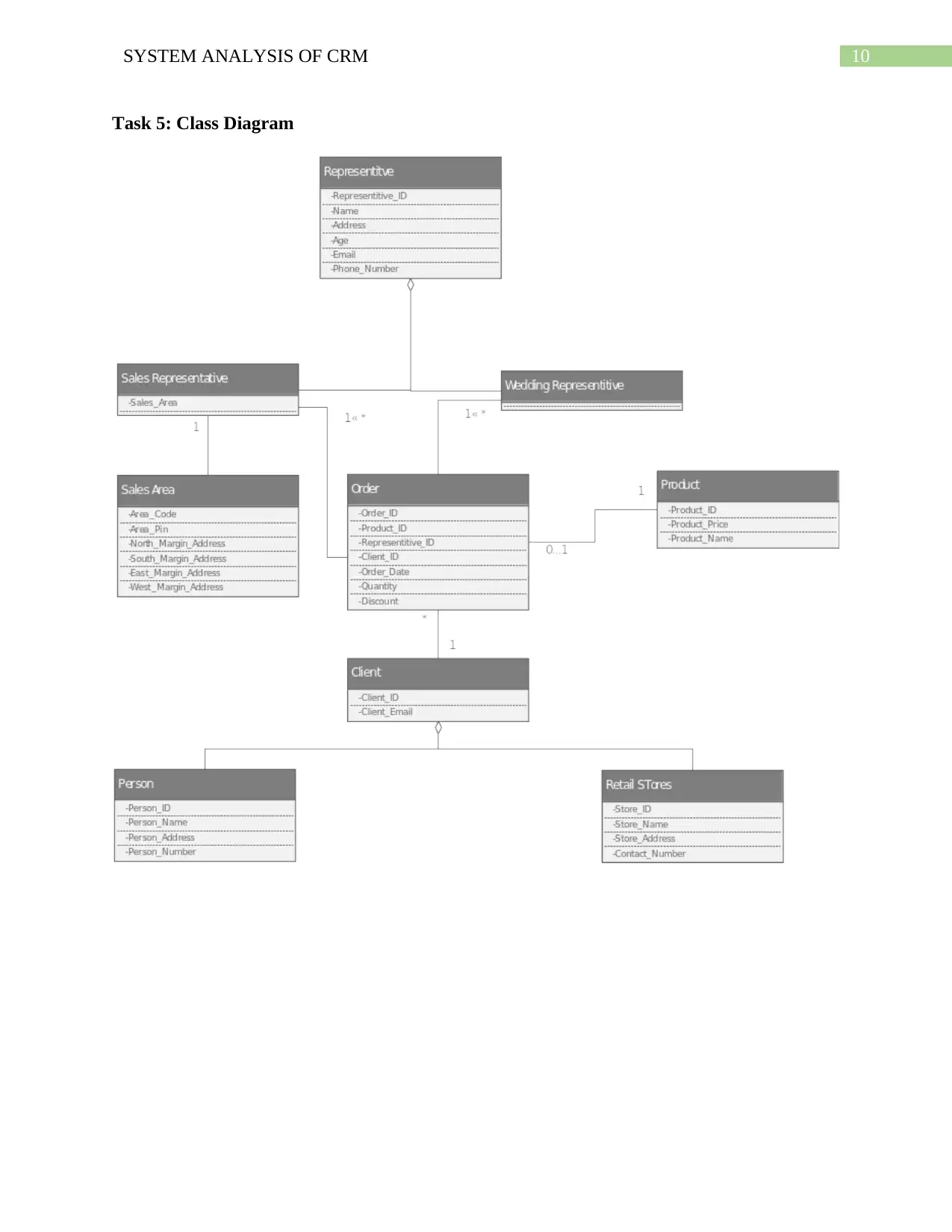
10SYSTEM ANALYSIS OF CRM
Task 5: Class Diagram
Task 5: Class Diagram
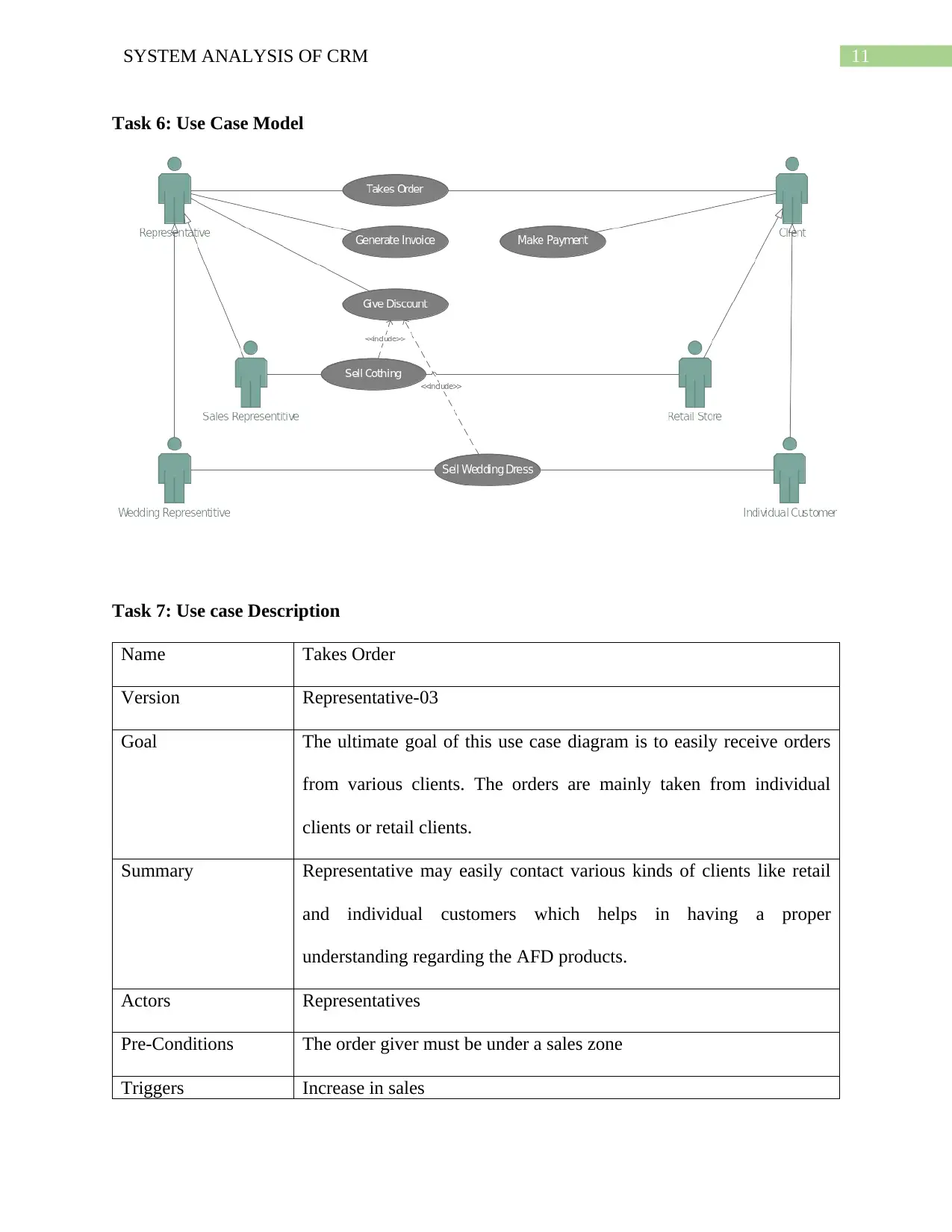
11SYSTEM ANALYSIS OF CRM
Task 6: Use Case Model
Task 7: Use case Description
Name Takes Order
Version Representative-03
Goal The ultimate goal of this use case diagram is to easily receive orders
from various clients. The orders are mainly taken from individual
clients or retail clients.
Summary Representative may easily contact various kinds of clients like retail
and individual customers which helps in having a proper
understanding regarding the AFD products.
Actors Representatives
Pre-Conditions The order giver must be under a sales zone
Triggers Increase in sales
Task 6: Use Case Model
Task 7: Use case Description
Name Takes Order
Version Representative-03
Goal The ultimate goal of this use case diagram is to easily receive orders
from various clients. The orders are mainly taken from individual
clients or retail clients.
Summary Representative may easily contact various kinds of clients like retail
and individual customers which helps in having a proper
understanding regarding the AFD products.
Actors Representatives
Pre-Conditions The order giver must be under a sales zone
Triggers Increase in sales
⊘ This is a preview!⊘
Do you want full access?
Subscribe today to unlock all pages.

Trusted by 1+ million students worldwide
1 out of 15
Related Documents
Your All-in-One AI-Powered Toolkit for Academic Success.
+13062052269
info@desklib.com
Available 24*7 on WhatsApp / Email
![[object Object]](/_next/static/media/star-bottom.7253800d.svg)
Unlock your academic potential
Copyright © 2020–2025 A2Z Services. All Rights Reserved. Developed and managed by ZUCOL.




